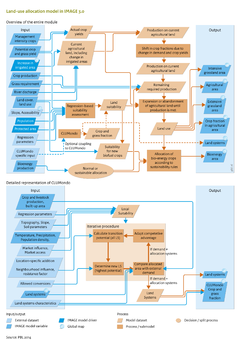Land-use allocation/Policy issues: Difference between revisions
Jump to navigation
Jump to search
No edit summary |
No edit summary |
||
| Line 1: | Line 1: | ||
{{ComponentPolicyIssueTemplate | {{ComponentPolicyIssueTemplate | ||
|Description=In a | |Description=In a baseline scenario, agricultural area increases at the expense of forest and other natural areas (for instance, [[PBL, 2012]]). The land-use allocation model is used to indicate where these changes may occur (see figure below). Thus, it helps to assess the consequence of agricultural expansion and intensification in specific ecosystems. | ||
|Example=The policy | |||
|Example=The policy interventions that can be analysed are related to either the agricultural economy ([[Agricultural economy and forestry]]), or they are reflected in the allocation rules used in the land-use allocation module (e.g. more protected areas, {{AbbrTemplate|REDD+}} schemes). In a study using the OECD Environmental Outlook scenario, the model was used to evaluate impacts of protection levels of natural areas: on top of a baseline scenario with strong bioenergy mandates, it was assumed that 20% (Prot20) of 50% (Prot50) of the land area were protected as nature reserves, or that all forest and woodland was protected from agricultural expansion (see figure below). The relative reduction in land use and CO2 emissions differ greatly depending on the type of areas protected. If forests are protected, almost the same amount of agricultural land is used by switching to non-forested land. Thus CO2 emissions are reduced, but reduction in land use and related biodiversity loss is much less. | |||
}} | }} | ||
Revision as of 15:47, 5 May 2014
Parts of Land-use allocation/Policy issues
| Component is implemented in: |
| Components: |
| Related IMAGE components |
| Projects/Applications |
| Key publications |
